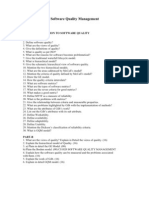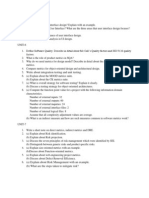0 ratings0% found this document useful (0 votes)
1 viewsQues
Ques
Uploaded by
MD ARIFSE
Copyright:
© All Rights Reserved
Available Formats
Download as DOCX, PDF, TXT or read online from Scribd
Ques
Ques
Uploaded by
MD ARIF0 ratings0% found this document useful (0 votes)
1 views3 pagesSE
Original Title
ques
Copyright
© © All Rights Reserved
Available Formats
DOCX, PDF, TXT or read online from Scribd
Share this document
Did you find this document useful?
Is this content inappropriate?
SE
Copyright:
© All Rights Reserved
Available Formats
Download as DOCX, PDF, TXT or read online from Scribd
Download as docx, pdf, or txt
0 ratings0% found this document useful (0 votes)
1 views3 pagesQues
Ques
Uploaded by
MD ARIFSE
Copyright:
© All Rights Reserved
Available Formats
Download as DOCX, PDF, TXT or read online from Scribd
Download as docx, pdf, or txt
You are on page 1of 3
1)Explain Software development process models.
2)Write a short note on Waterfall model.
3)Explain the importance of software specification of requirements.
4)Write a short note on Context Model.
5)Describe various prototyping techniques and discuss on object oriented analysis and
modeling. Briefly explain about the following:
Sequence diagram
Use case diagram.
6) What are the design principles of a good software design? Explain.
7) What is testing? How is it different from debugging?
8) Explain various structural testing techniques with suitable examples. List and explain the
various software quality factors.
9) Describe the role of software reviews in achieving good quality software
10) Explain about evolution of software engineering methodologies
11) What are the challenges of Software Engineering?
12) What is software maintenance? How to control maintenance cost.
13) Define software. List and explain about the elements of a software process
14) What is a change? How it can be incorporated in the software.
15) What is the difference between verification and validation? Explain with an example.
16) How system modeling is achieved using UML? Explain with a suitable example.
17) How we perform design evaluation? Explain it with suitable example.
18) Discuss briefly about Pro-active and Re-active Risk strategies in detail.
19) Explain about Software risks in detail.
20) What is black box testing? Is it necessary to perform this? Explain various test activities.
21) What is the goal of requirements analysis phase? Give reasons why the requirements
analysis phase is a difficult one.
22) Identify and briefly describe four types of requirement that may be defined for a
computer based.Explain the following:
a) Statistical SQA
b) Developing a risk table
23) Explain the following:
a) Software Quality Concepts
b) Risk Identification
24) What is integration testing? Explain in detail.
25) Discuss about metrics for testing in detail.
26) Distinguish between verification and validation. Explain about organizing for software
testing.
27) Explain about the metrics for design model.
28) Define software. Explain in detail about software myths.
29) Discuss in detail about water fall process model.
30) What is a process model? Explain about prototyping model in detail.
31) What is CMMI? Explain about CMMI levels.
32) Explain about requirements management phases of requirement engineering process.
33) Explain about state machine models with examples.
34) Based on your experience with a bank ATM, draw a data-flow diagram modelling the
data processing involved when a customer withdraws cash from the machine.
35) Discuss about architectural design in brief.
36) What are building blocks of the UML? Explain.
37) Explain about refining the architecture into components.
38) Distinguish between sequence and collaboration diagrams.
39) Briefly explain about the design model.
40) Explain in detail about evolutionary process model.
41) What are the advantages of layered technology?
42) Describe the structure of Software Requirements document.
43) Briefly explain about Context models.
44) Explain the differences between functional requirements and non-functional
requirements.
45) Briefly explain about structured methods.
46) Briefly explain about interface analysis and interface design steps.
47) Write a short note on class diagrams.
48) Write a short note on component diagrams.
49) Explain the process of creating models and the factors that should be considered when
building models.
50) What are the metrics for Analysis Model? Explain.
51) Write a short note on system testing.
52) Describe about formal technical reviews.
53) Explain the methods for Risk Identification.
54) Explain CMMI model with a neat sketch.
55) Give an overview of unified process model.
56) Discuss in brief about the waterfall model.
57) Explain process patterns and process assessment.
58) Describe five desirable characteristics of a good software requirement specification
document.
59) Give an overview of various system models.
60) Discuss about principal requirements engineering activities and their relationships.
61) Explain how a software requirements document is structured.
62) Write a short notes on data design.
63) Describe architectural styles and patterns.
64) Explain the following diagrams:
a) Class diagrams and sequence diagrams
b) Collaboration diagrams and use case diagrams.
65) Describe strategic approach to software testing.
66) Explain Software quality and metrics for analysis model.
67) Illustrate various Metrics for Process and Products.
You might also like
- Quality 101 - Quality Assurance Question and Answers - TrenovisionDocument92 pagesQuality 101 - Quality Assurance Question and Answers - TrenovisionShadow Gaming100% (1)
- SQM 16 & 2marks With AnsDocument21 pagesSQM 16 & 2marks With AnsKalyan SundaramNo ratings yet
- Cdac SEDocument8 pagesCdac SEAnuj ChoukseyNo ratings yet
- DTC P0341: CMP Sensor A and CKP Sensor Incorrect Phase DetectedDocument4 pagesDTC P0341: CMP Sensor A and CKP Sensor Incorrect Phase Detectedmzcz3866100% (1)
- 2zz-Cylinder Head - InstallationDocument5 pages2zz-Cylinder Head - InstallationGullwing Motor Service100% (1)
- A Developed Autonomous Preventive Maintenance Programme Using RCA and FMEADocument10 pagesA Developed Autonomous Preventive Maintenance Programme Using RCA and FMEAGuilherme CentenaroNo ratings yet
- SE QuestionsDocument3 pagesSE QuestionsGouthami JukantiNo ratings yet
- SOTWARE ENGINEERING-case Tools LabDocument2 pagesSOTWARE ENGINEERING-case Tools Labmuhammadkamran05100% (1)
- Short Ans SEDocument2 pagesShort Ans SEMD ARIFNo ratings yet
- Se QBDocument6 pagesSe QBpriyajv14No ratings yet
- Imp Que SeDocument2 pagesImp Que Se07Karan DesaiNo ratings yet
- SE Assignment QuestionsDocument2 pagesSE Assignment QuestionsKousheek MahendaranNo ratings yet
- SE Question Bank-1Document2 pagesSE Question Bank-1samacc0907No ratings yet
- SDE Question BankDocument6 pagesSDE Question BankM HARSHITHA 20R01A05M7No ratings yet
- SE - 2011 - 2nd EditionDocument9 pagesSE - 2011 - 2nd EditionRam GopalNo ratings yet
- Software Engineering Question Bank - KAKDocument2 pagesSoftware Engineering Question Bank - KAKRehan PathanNo ratings yet
- Software Engineering QBDocument6 pagesSoftware Engineering QBKarthick ThiyaguNo ratings yet
- Syit Software Engineering Question BankDocument3 pagesSyit Software Engineering Question Bankyadneshkadam9892No ratings yet
- QuestionBank SEDocument2 pagesQuestionBank SEPratik ShuklaNo ratings yet
- SE Que Lis 160701Document5 pagesSE Que Lis 160701has_meceNo ratings yet
- SWENGGG QBankDocument6 pagesSWENGGG QBankKarthick ThiyaguNo ratings yet
- Unit Wise BankDocument35 pagesUnit Wise BankThirupathi Reddy LingalaNo ratings yet
- 15Cs42: Software Engineering Question BankDocument6 pages15Cs42: Software Engineering Question BankSyeda AfreenNo ratings yet
- Ia2 Se Question BankDocument2 pagesIa2 Se Question Bankfs20if014No ratings yet
- PDDDocument5 pagesPDDSimbhu Ashok CNo ratings yet
- SE Important QuestionsDocument2 pagesSE Important Questionsd87522585No ratings yet
- SQM Important QuestionsDocument4 pagesSQM Important QuestionsShankar Prakash GNo ratings yet
- Se QBDocument2 pagesSe QBtilgulkarvaishnaviNo ratings yet
- SE Module Wise QuestionsDocument3 pagesSE Module Wise QuestionsVailantan FernandesNo ratings yet
- Se QbankDocument4 pagesSe QbankMohammad samiNo ratings yet
- AssinmentDocument2 pagesAssinmentvolatility75sNo ratings yet
- SE QuestionBankDocument12 pagesSE QuestionBanksharmadhruv2808No ratings yet
- Cs1020 Software Quality Management Question Bank: Department of Computer Science and Engineering Question BankDocument6 pagesCs1020 Software Quality Management Question Bank: Department of Computer Science and Engineering Question BankVignesh KumarNo ratings yet
- DEC-2008 System Analysis and Design (Cs - 301) Section - ADocument4 pagesDEC-2008 System Analysis and Design (Cs - 301) Section - AAnu GargNo ratings yet
- Department of Computer Science and Engineering Question BankDocument11 pagesDepartment of Computer Science and Engineering Question BankDevi SriNo ratings yet
- Question Bank Software EngineeringDocument2 pagesQuestion Bank Software EngineeringRudra SinghNo ratings yet
- Software Engineering QUESTION BANKDocument11 pagesSoftware Engineering QUESTION BANKHema MaheNo ratings yet
- S.E Final Q.BDocument5 pagesS.E Final Q.BbhagyashribbsccsNo ratings yet
- Mc9233 Software EngineeringDocument10 pagesMc9233 Software EngineeringnovfelnawzinNo ratings yet
- Question BankDocument11 pagesQuestion Bankjain100% (2)
- Se QBDocument11 pagesSe QBBrad WarrenNo ratings yet
- Write About Integration Testing and Unit TestingDocument2 pagesWrite About Integration Testing and Unit TestingdeeuGirlNo ratings yet
- Question Bank Software EngineerningDocument9 pagesQuestion Bank Software EngineerningZaheer AbbasNo ratings yet
- Ase QBDocument5 pagesAse QBfakeme9971No ratings yet
- SE (Q Bank)Document3 pagesSE (Q Bank)SHARK GAMINGNo ratings yet
- SE QB For CIE-1Document3 pagesSE QB For CIE-1narasimhayalakarajulaNo ratings yet
- SQA Question BankDocument4 pagesSQA Question BankShabbeer BashaNo ratings yet
- SPM QB-1 (E-Next - In)Document2 pagesSPM QB-1 (E-Next - In)addk572No ratings yet
- 8U5CSSB - Software Engineering QSDocument2 pages8U5CSSB - Software Engineering QSBehin SamNo ratings yet
- SE QuesDocument2 pagesSE Queskaps_er_3No ratings yet
- Cs2301 - Software Engineering-November 2010Document2 pagesCs2301 - Software Engineering-November 2010Iraniya PandiyanNo ratings yet
- SPM QBDocument2 pagesSPM QB8097161849aNo ratings yet
- SE QB - 2011 - 1st EditionDocument21 pagesSE QB - 2011 - 1st EditionDhanaraj ShanmugasundaramNo ratings yet
- Sa 2003 Comp ItDocument3 pagesSa 2003 Comp ItabhijitjustcoolNo ratings yet
- Kings: UNIT-1 Part (2 Marks)Document4 pagesKings: UNIT-1 Part (2 Marks)Sai SwethaNo ratings yet
- BCA206 QB BCA 1yrDocument6 pagesBCA206 QB BCA 1yrpornisbad4healthNo ratings yet
- Assignment No 3,4,5 SeDocument3 pagesAssignment No 3,4,5 SeAnushka GuptaNo ratings yet
- EndSemModelQuestions SEnggDocument1 pageEndSemModelQuestions SEnggrishabhmcu001No ratings yet
- Software Testing & Quality AssuranceDocument3 pagesSoftware Testing & Quality Assurancek20pro9t4No ratings yet
- Engineering Principles of Combat Modeling and Distributed SimulationFrom EverandEngineering Principles of Combat Modeling and Distributed SimulationNo ratings yet
- Mastering Software Engineering: From Basics to Expert ProficiencyFrom EverandMastering Software Engineering: From Basics to Expert ProficiencyNo ratings yet
- Mechanical Engineers' Handbook, Volume 2: Design, Instrumentation, and ControlsFrom EverandMechanical Engineers' Handbook, Volume 2: Design, Instrumentation, and ControlsNo ratings yet
- Introduction to Digital Systems: Modeling, Synthesis, and Simulation Using VHDLFrom EverandIntroduction to Digital Systems: Modeling, Synthesis, and Simulation Using VHDLNo ratings yet
- Project Metrics and ManagementDocument32 pagesProject Metrics and ManagementSita kumarNo ratings yet
- Mapping Requirements Into Software ArchitectureDocument8 pagesMapping Requirements Into Software ArchitectureHaroon ZafarNo ratings yet
- It301 Week 12 To 13Document3 pagesIt301 Week 12 To 13Beriah Buan100% (1)
- Engine Tech Tips: Subject: DPR Inspection 1. Relevant ModelsDocument4 pagesEngine Tech Tips: Subject: DPR Inspection 1. Relevant ModelsVictor MontesdeocaNo ratings yet
- Project Management Information SystemDocument60 pagesProject Management Information SystemElvira Lopez AndadiNo ratings yet
- MecatronicsDocument21 pagesMecatronicsHussien KafafyNo ratings yet
- C Programming Language Complete Reference 2021Document270 pagesC Programming Language Complete Reference 2021gouthamat38No ratings yet
- Chapter 4 Documenting Information SystemDocument25 pagesChapter 4 Documenting Information SystemMarc Geoffrey HababNo ratings yet
- Technical Management of Software Development: Experiences, Tips and Ideas Alex MartelliDocument45 pagesTechnical Management of Software Development: Experiences, Tips and Ideas Alex MartelliMukundan NarayananNo ratings yet
- An Expert System For Automobile Repairs and Maintenance: December 2018Document17 pagesAn Expert System For Automobile Repairs and Maintenance: December 2018Ola MikeNo ratings yet
- First Review PPT Template (20-24)Document16 pagesFirst Review PPT Template (20-24)thesahara7No ratings yet
- Vaishnavi S Kulkarni: Work ExperienceDocument1 pageVaishnavi S Kulkarni: Work ExperienceVaishnavi KulkarniNo ratings yet
- Outline - Essay and Argumentative EssayDocument2 pagesOutline - Essay and Argumentative EssayGabbo GómezNo ratings yet
- Ba ZC471 Course HandoutDocument4 pagesBa ZC471 Course HandoutirfanNo ratings yet
- AOM QB MCQ Part 1 To Part10Document21 pagesAOM QB MCQ Part 1 To Part10Raj aryan100% (2)
- Case 1: ProblemDocument5 pagesCase 1: ProblemVismathiNo ratings yet
- CatalogoDocument194 pagesCatalogohugo renzo chavez bernuyNo ratings yet
- Fmea & CP FormsDocument16 pagesFmea & CP FormswebtecnicaNo ratings yet
- 6th SEM QB-MADDocument3 pages6th SEM QB-MADTanvir RahmanNo ratings yet
- Chapter 1 PDFDocument28 pagesChapter 1 PDFAzka GilaniNo ratings yet
- IPC Communications Product Life Cycle Summary Q4 2022Document4 pagesIPC Communications Product Life Cycle Summary Q4 2022sergio pailamillaNo ratings yet
- Project Monitoring and Evaluation and Its ImportanceDocument47 pagesProject Monitoring and Evaluation and Its ImportanceChiranjivi KuthumiNo ratings yet
- AUTOSAR EXP ErrorDescriptionDocument79 pagesAUTOSAR EXP ErrorDescriptionTan HuynhNo ratings yet
- Uvm Training BangaloreDocument2 pagesUvm Training BangaloreVlsi GuruNo ratings yet
- Co, Po, Pso Mapping LAB-C316Document7 pagesCo, Po, Pso Mapping LAB-C316Mahi MaheshNo ratings yet
- NO.1 A. B. C. D.: AnswerDocument7 pagesNO.1 A. B. C. D.: Answers-tinyNo ratings yet

























































































